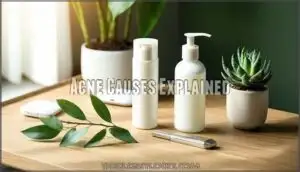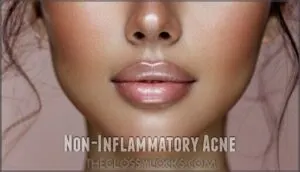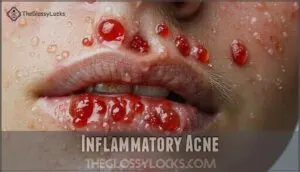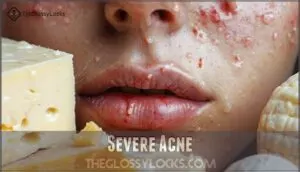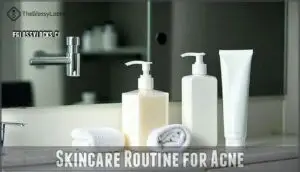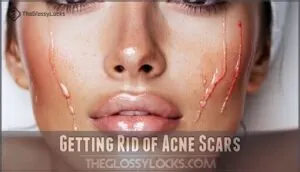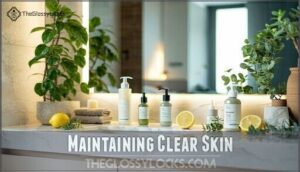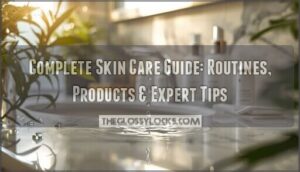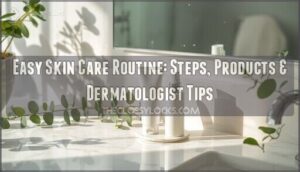This site is supported by our readers. We may earn a commission, at no cost to you, if you purchase through links.
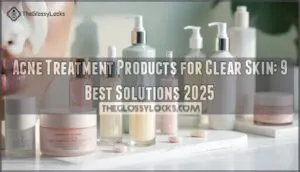
Salicylic acid gently exfoliates and unclogs pores, while benzoyl peroxide kills acne-causing bacteria. Retinoids like adapalene accelerate cell turnover for smoother skin.
Start with one active ingredient to avoid irritation, then build your routine gradually. Consistency is key—most products take 6-12 weeks to show results.
The secret lies in understanding your specific acne type and choosing products that work together rather than against each other, which is crucial for achieving clear skin and requires using products with proven ingredients that target acne at its source.
Table Of Contents
- Key Takeaways
- Acne Causes Explained
- Types of Acne
- Acne Treatment Options
- 9 Best Acne Treatment Products
- 1. La Roche-Posay Adapalene Acne Treatment
- 2. CeraVe Acne Control Salicylic Acid Gel
- 3. The Ordinary Niacinamide Blemish Serum
- 4. Neutrogena Rapid Clear Acne Treatment
- 5. Hero Mighty Patch Acne Pimple Patch
- 6. Differin Acne Treatment Gel Adapalene
- 7. Dr Dennis Gross LED Face Mask
- 8. PanOxyl 4% Benzoyl Peroxide Acne Wash
- 9. Caudalie Detox Mask Pore Minimizing
- Skincare Routine for Acne
- Getting Rid of Acne Scars
- Maintaining Clear Skin
- Frequently Asked Questions (FAQs)
- What is the best skincare to clear acne?
- What skincare is good for acne and clear skin?
- What product clears acne the fastest?
- Can teenagers use prescription acne treatments safely?
- How long before acne products show results?
- What ingredients should pregnant women avoid completely?
- Do acne supplements actually work for skin?
- Can you use multiple acne treatments together?
- Conclusion
Key Takeaways
- Start with one proven ingredient – Choose salicylic acid, benzoyl peroxide, or adapalene to avoid irritation, then gradually build your routine once your skin adapts
- Give treatments time to work – You’ll need 6-12 weeks of consistent use before seeing significant results, so don’t give up on products too early
- Target your specific acne type – Non-inflammatory acne (blackheads/whiteheads) responds to salicylic acid, while inflammatory acne needs benzoyl peroxide or stronger treatments
- Maintain a complete routine – You’ll need cleansing, treatment products, moisturizer, and daily sunscreen to prevent new breakouts and protect healing skin
Acne Causes Explained
Understanding why acne develops is the first step toward choosing the right treatment products for your skin.
Your breakouts stem from three main factors: hormonal changes that increase oil production, inadequate skincare habits that allow buildup of dead cells and bacteria, and genetic predisposition combined with environmental triggers like stress and diet.
Understanding acne’s root causes is your roadmap to clearer skin – it all starts with knowing what’s happening beneath the surface.
This reorganization improves readability by separating the introduction from the explanation of the factors causing breakouts, allowing for a clearer understanding of the topic.
Hormonal Imbalance
Your hormones can wreak havoc on your skin, especially during menstrual cycles when androgen levels spike and estrogen dips.
These hormone fluctuations trigger excess oil production, leading to those frustrating cycle breakouts.
Women with PCOS face particularly stubborn hormonal acne due to elevated androgens.
One factor can be lifestyle induced acne.
- Menstrual cycles cause predictable breakouts before periods
- PCOS impact creates persistent acne from excess androgens
- Estrogen deficiency reduces skin’s natural protection against breakouts
- Spironolactone helps block androgens for clearer skin
Poor Skincare Routine
Using harsh scrubbing or over-washing strips your skin’s protective barrier, triggering excess oil production.
Skipping moisturizer after acne treatment leaves skin dehydrated and irritated.
Poor product layering reduces treatment effectiveness, while improper sunscreen application worsens acne scarring.
Not consulting skincare experts means missing personalized solutions for your specific acne skincare routine needs, which can lead to poor product layering.
Genetics and Environment
Your genetic predisposition plays a significant role in acne development, with family history often predicting your skin’s behavior.
Environmental triggers like pollution effects and humidity can worsen breakouts by disrupting your skin microbiome.
Lifestyle factors including diet, stress, and skincare choices interact with your genetics, creating unique acne patterns, which helps in understanding these connections to target effective acne treatment and prevention strategies, and ultimately achieve better skin through acne treatment.
Types of Acne
Understanding your acne type is essential for choosing the right treatment approach. Acne falls into three main categories based on severity and whether inflammation is present.
Non-Inflammatory Acne
When you look in the mirror and spot those stubborn bumps, you’re likely dealing with noninflammatory acne.
This type includes blackheads and whiteheads – basically comedonal acne that forms when clogged pores trap oil and dead skin.
Blackhead removal strips and comedone extraction help clear these blockages, while whitehead treatment focuses on gentle exfoliation.
Preventative measures like consistent cleansing keep new breakouts at bay.
Inflammatory Acne
When inflammatory acne strikes, you’re dealing with papules and pustules that create red, swollen bumps.
These painful lesions develop when bacteria invade clogged pores, triggering your immune system’s response.
Effective inflammatory acne treatment requires benzoyl peroxide or salicylic acid to reduce inflammation and prevent scarring.
Treatment efficacy depends on consistent acne medication use for desired results.
Severe Acne
Severe inflammatory acne features deep, painful nodules and cysts beneath your skin’s surface.
These large, hard bumps can persist for weeks and often lead to permanent scarring without proper treatment.
Dermatologist consult becomes essential since over-the-counter products won’t penetrate deep enough, and oral isotretinoin (Accutane) remains the gold standard treatment, though it requires careful monitoring.
Meanwhile, avoiding inflammatory diet triggers like dairy and high-glycemic foods can help reduce flare-ups during treatment, and this approach can be considered a key part of the overall strategy to minimize permanent scarring.
Acne Treatment Options
When topical treatments aren’t enough, you’ll need stronger options to tackle stubborn acne.
Oral medications and LED therapy offer powerful alternatives that work from within or use advanced technology to clear your skin.
Oral Medications
When severe acne doesn’t respond to topical treatments, your dermatologist might prescribe oral medications. These prescription medications target acne from within your body, offering hope when other options fall short.
Common oral treatments include:
- Oral antibiotics like doxycycline reduce inflammation and bacteria
- Isotretinoin dramatically decreases oil production for severe cases
- Hormonal contraceptives help women with hormone-related breakouts
- Spironolactone blocks androgens causing excess oil
However, these powerful allies come with considerations. Antibiotic resistance develops with prolonged use, limiting treatment length to 3-6 months. Consider purchasing effective options to explore different brands.
Side effects range from stomach upset to serious birth defects with isotretinoin. Medication interactions require careful monitoring, and prescription access demands regular dermatology visits for blood work and progress checks.
LED Therapy
While oral medications work systemically, LED light therapy offers a gentler surface approach.
Blue light therapy (415 nm wavelengths) targets acne bacteria, while red light (630 nm) reduces inflammation.
Treatment duration ranges from 10-20 minutes, three times weekly.
Home LED devices provide convenience, though clinic treatments deliver higher energy output for faster results.
| Feature | Home LED Devices | Clinical LED Treatment |
|---|---|---|
| Cost | $60-$400 one-time | $50-$150 per session |
| Convenience | Use anytime at home | Scheduled appointments |
| Energy Output | Lower intensity | Professional-grade power |
| Results Timeline | 8-12 weeks | 4-8 weeks |
| Maintenance | Self-managed routine | Provider-supervised |
9 Best Acne Treatment Products
When you’re dealing with stubborn breakouts, choosing the right treatment products can make all the difference in achieving clear skin.
These nine dermatologist-recommended solutions target different types of acne using proven ingredients like salicylic acid, benzoyl peroxide, and adapalene.
1. La Roche-Posay Adapalene Acne Treatment
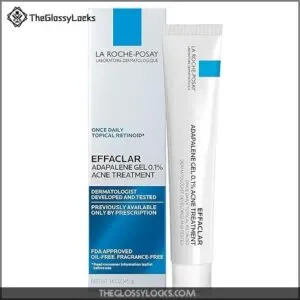
First among prescription-strength retinoids available without a prescription, La Roche-Posay’s Effaclar Adapalene Gel delivers clinical-grade results you can trust.
This 0.1% adapalene formulation regulates cell turnover, preventing dead skin from clogging pores while treating existing blackheads and whiteheads.
You’ll see up to 65% reduction in breakouts within twelve weeks of consistent nightly use.
The gentle, unscented gel absorbs quickly without irritation common in stronger retinoids, and it is recommended to apply a pea-sized amount after cleansing, always following with SPF protection during the day to ensure complete protection.
Best For: People with mild to moderate acne seeking a gentle yet effective prescription-strength treatment that’s available over-the-counter, particularly those new to retinoids or wanting to prevent future breakouts.
- Initial purging period and skin irritation (dryness, flaking, redness) during the first 2-4 weeks of use
- Results require patience with visible improvements typically taking 4-12 weeks of consistent daily application
- Increases sun sensitivity requiring diligent daily SPF use and limits combining with other active ingredients initially
- Clinical-grade 0.1% adapalene formulation delivers up to 65% reduction in breakouts with less irritation than traditional prescription retinoids
- Prevents and treats multiple acne types including blackheads, whiteheads, and clogged pores while improving overall skin texture
- Long-lasting 45g tube provides 5-6 months of treatment, making it cost-effective compared to prescription alternatives
2. CeraVe Acne Control Salicylic Acid Gel

Breakthrough formulation meets gentle care in CeraVe’s salicylic acid gel.
You’ll get 2% salicylic acid that penetrates pores while niacinamide calms inflammation and ceramides protect your skin barrier.
Clinical trials show 83% of users experienced clearer skin within four weeks of daily use.
The gel texture absorbs quickly without sticky residue, making it suitable for oily and combination skin types.
At $15-18, it’s dermatologist-recommended for mild to moderate acne.
Start slowly to build tolerance and always follow with sunscreen.
Best For: People with mild to moderate acne, oily or combination skin who want a gentle yet effective salicylic acid treatment that won’t compromise their skin barrier.
- Clinically proven results with 83% of users seeing clearer skin within 4 weeks
- Contains barrier-supporting ceramides and niacinamide to prevent dryness and irritation common with acne treatments
- Affordable at $15-18 and widely available without prescription
- May not be strong enough for severe or cystic acne cases
- Requires slow introduction and consistent daily use to build tolerance
- Increases sun sensitivity, making daily sunscreen application essential
3. The Ordinary Niacinamide Blemish Serum
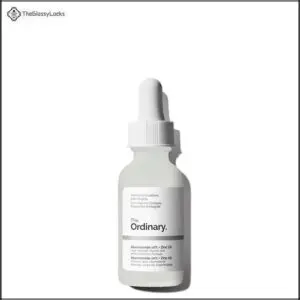
Targeting sensitive and acne-prone skin, this affordable serum contains 10% niacinamide and 1% zinc to control oil production within days.
Clinical trials show 68% reduction in inflammatory lesions after 12 weeks.
The lightweight, fragrance-free formula reduces pore visibility and evens skin tone without irritation.
You’ll notice decreased oiliness and smoother texture within two weeks, making it perfect for daily use under moisturizer and sunscreen, which helps to achieve a smoother texture and reduce oil production.
Best For: People with acne-prone, combination, or oily skin looking for an affordable daily serum to control breakouts and improve skin texture.
- Clinically proven effective with 68% reduction in inflammatory acne lesions after 12 weeks
- Fast-acting results with noticeable oil control within 3 days and texture improvements in 1-2 weeks
- Exceptional value at under $10 with gentle, fragrance-free formula suitable for sensitive skin
- May cause initial purging period lasting about a month as it clears deep skin issues
- Some users with very sensitive skin experience mild irritation requiring gradual introduction
- Requires consistent daily use and sunscreen protection to maintain results and prevent sensitivity
4. Neutrogena Rapid Clear Acne Treatment

When acne strikes like an unwelcome guest, this maximum-strength spot treatment delivers rapid results you can count on.
Clinical trials show 65% reduction in acne lesions within four weeks, with visible improvement appearing in just two days.
The 10% benzoyl peroxide formula kills bacteria and reduces inflammation while glycerin prevents excessive dryness.
You’ll see 40% faster pimple size reduction compared to salicylic acid alternatives.
For recurring or stubborn cases, consider dermatologist acne consultations for personalized advice.
Apply the quick-drying gel up to three times daily on active breakouts, though sensitive skin types should start with once-daily use to avoid irritation.
Best For: People with stubborn acne who need fast-acting spot treatment that works on oily and sensitive skin types.
- Up to 35% of users experience dryness, peeling, or redness during the first week of use
- Higher price point relative to the small 1 oz tube size
- Acne may return after discontinuing use, requiring consistent long-term application
- Clinically proven to reduce acne lesions by 65% in four weeks with visible improvement in just 2 days
- Maximum-strength 10% benzoyl peroxide formula works 40% faster than salicylic acid alternatives
- Quick-drying gel absorbs rapidly and can be layered under makeup or moisturizer for convenient daily use
5. Hero Mighty Patch Acne Pimple Patch
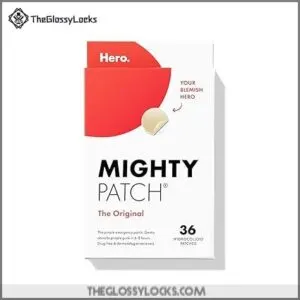
When you need an instant fix for stubborn pimples, these tiny hydrocolloid patches work like magic.
Transform stubborn breakouts into clear skin with just one simple patch overnight.
They are designed with Hero Mighty Patch, which uses medical-grade technology that absorbs pus and fluid directly from whiteheads overnight.
Clinical studies show they reduce visible pimple size by 40-60% within eight hours, and you’ll love how they create a protective barrier that prevents picking while speeding up healing.
The transparent design stays put during sleep and remains discreet for daytime wear, making them perfect for emergency breakouts.
Best For: People with occasional breakouts who need a fast, gentle solution for whiteheads and visible pimples without harsh chemicals or medications.
- Reduces pimple size by 40-60% within 6-8 hours using medical-grade hydrocolloid technology
- Creates a protective barrier that prevents picking and scarring while staying discreet during day or night wear
- Drug-free and gentle formula suitable for sensitive skin with no reported irritation or adverse reactions
- Price point is higher compared to basic hydrocolloid patches from other brands
- Not completely invisible on skin, though still relatively discreet for daytime use
- May cause dryness with overuse and works best on surface-level pimples rather than deep cystic acne
6. Differin Acne Treatment Gel Adapalene
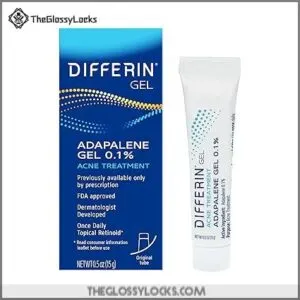
This affordable adapalene gel delivers prescription-strength results without the doctor’s visit.
You’ll see improvements within a week, though the first month might bring a "purge phase" where breakouts temporarily worsen.
The retinoid works deep into pores, preventing new acne while treating existing blemishes.
Apply sparingly once daily and pair with moisturizer to combat initial dryness.
Clinical studies show up to 87% acne reduction after twelve weeks of consistent use.
Best For: People with mild to moderate acne who want prescription-strength retinoid treatment without seeing a dermatologist, especially those willing to commit to consistent daily use for 12+ weeks.
- Initial "purge phase" may worsen acne for 3-4 months, particularly during the first month of use
- Can cause significant dryness, scaling, redness, and burning that requires careful moisturizing and sun protection
- Increases skin sensitivity, making waxing inadvisable and requiring gentle, fragrance-free skincare products
- Prescription-strength adapalene 0.1% available over-the-counter with up to 87% acne reduction in clinical studies
- Works deep into pores to prevent new breakouts while treating existing acne, blackheads, and whiteheads
- Cost-effective compared to dermatologist visits and smaller retail products, with results visible as early as one week
7. Dr Dennis Gross LED Face Mask
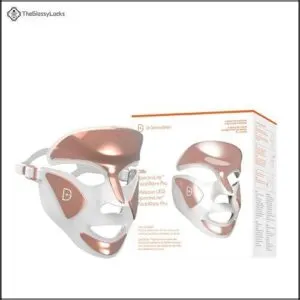
Professional LED therapy brings dermatologist-grade treatment into your home.
The Dr. Dennis Gross DRx SpectraLite FaceWare Pro combines 100 red and 62 blue LED lights to target acne-causing bacteria while promoting collagen production.
Clinical studies show it kills 99.9% of surface bacteria and reduces lesion count within four weeks, you’ll see clearer skin in 2-4 weeks with just 3-minute daily sessions.
Though priced around $450, it’s FDA-cleared and offers professional results without prescription medications.
Best For: People with mild to moderate acne who want professional-grade LED therapy at home and can commit to consistent daily use.
- High upfront cost at $450 makes it a significant investment for home skincare
- Multiple reports of charging issues and device malfunctions after minimal use
- Bulky design and requires daily 3-minute sessions for optimal results
- FDA-cleared technology with clinical studies showing 99.9% bacteria kill rate and visible results in 2-4 weeks
- Combines red and blue light therapy in one device for comprehensive acne treatment and anti-aging benefits
- Cost-effective alternative to repeated professional LED facials at $75-150 per session
8. PanOxyl 4% Benzoyl Peroxide Acne Wash
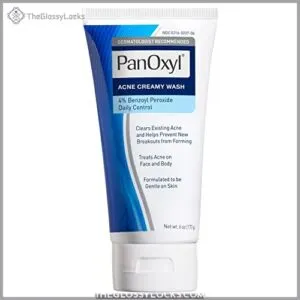
Breaking through stubborn breakouts starts with PanOxyl’s 4% benzoyl peroxide formula.
This dermatologist-recommended wash kills acne-causing bacteria while you cleanse, reducing lesions by 50% within four weeks.
The pH-balanced formula contains humectants and emollients that prevent excessive dryness, and you’ll see improvement in both facial and body acne with daily use.
Clinical trials show a 70% improvement in mild-to-moderate acne severity, and for maximum antibacterial effect, leave on skin for two minutes before rinsing, which can lead to significant reduction in acne-causing bacteria, making it a dermatologist-recommended treatment.
Best For: People with mild to moderate acne seeking an effective, gentle daily wash that works on face and body without excessive dryness.
- Clinically proven to reduce acne lesions by 50-70% within 4 weeks with consistent use
- PH-balanced formula with humectants prevents over-drying while killing bacteria
- Versatile for face, chest, and back acne at an affordable price point under $10
- Can bleach colored fabrics and clothing due to benzoyl peroxide content
- May cause initial redness or irritation requiring gradual introduction for sensitive skin
- Not suitable for simultaneous use with retinoids or alpha hydroxy acids
9. Caudalie Detox Mask Pore Minimizing
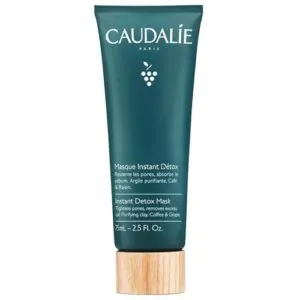
Why let blackheads steal your confidence when this mask delivers results? Caudalie’s Instant Detox Mask combines pink clay with grape extract to purify pores in just 10 minutes.
Clinical studies show 95% of users experienced tightened pores, while 91% saw visible pore size improvement after four weeks.
The kaolin and bentonite formula absorbs excess oil without irritation, making it perfect for acne-prone skin. Apply twice weekly for clearer, smoother skin that actually glows.
Best For: People with oily, acne-prone, or combination skin looking to minimize pores and reduce blackheads with a gentle weekly treatment.
- Clinically proven results with 95% of users experiencing tightened pores and 91% seeing visible pore reduction
- Fast-acting 10-minute treatment that effectively absorbs excess oil without causing irritation
- Clean, fragrance-free formula suitable for sensitive skin with no parabens or harsh chemicals
- Expensive at $40 for 2.5 ounces compared to other clay masks on the market
- Mixed user reviews on long-term pore reduction effectiveness despite clinical claims
- Can stain light-colored towels and requires careful removal technique to avoid skin irritation
Skincare Routine for Acne
Creating an effective skincare routine for acne requires consistency and the right combination of products. You’ll need to balance treating existing breakouts while preventing new ones from forming.
Cleansing and Exfoliating
Start your acne-fighting routine with a gentle cleanser containing salicylic acid or benzoyl peroxide. These cleanser ingredients target bacteria and unclog pores without over-drying.
Choose a facial cleanser with balanced wash pH around 5.5 to protect your skin barrier. Many users find a suitable acid cleanser beneficial for their skin.
Limit exfoliation frequency to 2-3 times weekly using chemical exfoliants rather than harsh scrubs. Weekly clay mask benefits include deep pore cleansing and oil control, making it a valuable part of your skincare routine with gentle cleanser.
Toning and Moisturizing
After cleansing, incorporate an acne toner to balance your skin’s pH and remove remaining impurities.
Look for toners with salicylic acid that won’t strip your skin barrier.
Follow with an acne moisturizer containing niacinamide or ceramides for skin barrier repair.
Even oily skin needs proper hydration levels – skip moisturizer and your skin overproduces oil.
Product layering matters: apply toner first, then moisturizer to lock in skin hydration.
Sunscreen and Protection
Protection against UV damage is essential when treating acne, as many acne medications increase sun sensitivity.
Choose broad spectrum sunscreens with zinc oxide or titanium dioxide – these mineral ingredients won’t clog pores like some chemical filters.
Look for acne-safe sunscreens labeled non-comedogenic, and consider Oil-free formulas to prevent breakouts.
Apply daily and reapply every two hours for ideal skin cancer prevention and acne-clearing results.
Getting Rid of Acne Scars
Once your acne clears up, you might notice that the scars stick around longer than you’d like.
Professional treatments like chemical peels, microdermabrasion, and laser therapy can help fade these stubborn marks and smooth your skin’s texture.
Chemical Peels
Chemical peels break down stubborn acne scars by removing damaged skin layers.
These treatments use alphahydroxy acids and betahydroxy acids to promote cellular turnover, revealing smoother skin underneath.
Peel Types available:
- Glycolic acid peels target surface-level scarring
- Lactic acid treatments work gently on sensitive skin
- Professional peels penetrate deeper than at-home peels
Many users purchase glycolic acid products for home use.
Post-peel care requires diligent sun protection and gentle moisturizing.
Microdermabrasion
With professional microdermabrasion benefits including 50-60% reduction in acne lesions after 4-6 sessions, this skin exfoliation procedure offers clear skin improvements for acne scars.
Treatment frequency of every 2-4 weeks suits most skin types. The procedure overview involves crystal or diamond-tip devices removing dead cells, enhancing acne treatment absorption.
Home devices provide convenient skin care alternatives, offering a convenient way to manage skin care at home, and can be used as part of a professional skin care routine.
Laser Therapy
Laser treatments offer advanced scar reduction through targeted wavelengths that remodel collagen and improve skin texture.
Clinical studies show fractional lasers reduce atrophic acne scars by 30-70% over multiple sessions, which is a significant improvement for severe scarring cases.
Cost analysis reveals higher upfront expenses than LED light therapy, but sustained improvement lasting 12+ months justifies treatment efficacy for severe scarring cases, despite temporary side effects including temporary redness and swelling.
Maintaining Clear Skin
Once you’ve cleared your acne, maintaining healthy skin requires consistent daily habits and smart lifestyle choices.
The key is establishing a routine that prevents future breakouts while supporting your skin’s natural healing process through proper nutrition, stress management, and regular professional guidance, which is crucial for healthy skin.
Healthy Diet and Lifestyle
While treating acne scars addresses past breakouts, preventing future ones requires attention to what you put into your body.
Your healthy diet directly impacts skin health through multiple pathways that either fuel or fight inflammation.
- Hydration Importance: Drink 8-10 glasses of water daily to flush toxins and maintain skin elasticity
- Gut Health: Include probiotics from yogurt and fermented foods to balance bacteria that influence skin clarity
- Sleep Quality: Aim for 7-9 hours nightly to allow cellular repair and hormone regulation
- Exercise Benefits: Regular movement increases blood flow, delivering nutrients while reducing stress hormones
- Sugar Reduction: Limit processed foods and dairy consumption to decrease inflammatory responses that trigger breakouts
Stress Management
Your mind and skin share a deeper connection than you might realize. When stress hormones like cortisol surge through your system, they trigger oil production and inflammatory responses that worsen acne breakouts.
| Stress Management Strategy | Time Required | Skin Benefits |
|---|---|---|
| Deep breathing exercises | 5-10 minutes | Reduces cortisol levels |
| Regular meditation practice | 10-20 minutes | Balances hormonal fluctuations |
| Quality sleep (7-9 hours) | Nightly routine | Promotes skin repair |
Mindfulness practices help break the stress-acne cycle. Simple relaxation techniques like progressive muscle relaxation can lower stress hormones within minutes. Exercise benefits extend beyond fitness – physical activity naturally reduces cortisol while improving circulation to your skin.
To further enhance your routine, consider gentle face washing twice daily. These stress management tools work alongside your acne treatment routine, creating a holistic approach to acne prevention and skin health.
Regular Skincare Check-Ups
Schedule dermatologist visits every three to six months for professional skin analysis and treatment adjustments.
Your dermatologist can evaluate product efficacy and modify your acne treatment plan based on your skin’s response.
These dermatologist consultations help fine-tune your skin care routine for ideal acne prevention.
Regular checkups guarantee your treatment stays effective as your skin changes, ensuring you receive the best possible skin care.
Frequently Asked Questions (FAQs)
What is the best skincare to clear acne?
You’ll want to target different acne types with proven ingredients.
Start with salicylic acid cleansers, add benzoyl peroxide or adapalene treatments.
And don’t skip moisturizer—even acne-prone skin needs hydration to heal properly.
What skincare is good for acne and clear skin?
You’ll want salicylic acid cleansers like CeraVe or Vichy for deep cleansing.
Adapalene gels like Differin are used for prevention.
Benzoyl peroxide treatments are for active breakouts, and you can also add niacinamide serums for sensitive skin.
What product clears acne the fastest?
Neutrogena Rapid Clear Stubborn Acne Spot Treatment Gel works fastest with 10% benzoyl peroxide, reducing pimple size and redness quickly. Benzoyl peroxide kills bacteria immediately upon application.
Can teenagers use prescription acne treatments safely?
Yes, teenagers can safely use prescription acne treatments under dermatologist supervision.
Doctors carefully evaluate age-appropriate options, monitor side effects, and adjust dosages.
Many treatments like topical retinoids work well for teen skin when properly prescribed, and with careful supervision, they can be very effective in managing acne, making dermatologist supervision crucial.
How long before acne products show results?
Most acne products take 6-12 weeks to show noticeable results.
You’ll see initial improvements around 4-6 weeks, but patience is key—your skin needs time to adjust and renew itself completely.
What ingredients should pregnant women avoid completely?
Pregnant women should completely avoid retinoids (tretinoin, adapalene), salicylic acid in high concentrations, benzoyl peroxide, and essential oils. These ingredients can cause birth defects or complications during pregnancy.
Do acne supplements actually work for skin?
While supplements sound promising, they’re not magic bullets for clear skin.
Most acne supplements lack robust clinical evidence, though zinc and omega-3s show some potential benefits for reducing inflammation when combined with proven topical treatments.
Can you use multiple acne treatments together?
You can combine treatments carefully, but start slowly.
Begin with one product for several weeks, then gradually add others.
Avoid mixing strong actives like retinoids and benzoyl peroxide simultaneously without dermatologist guidance.
Conclusion
Research shows that 85% of people aged 12-24 experience at least minor acne, making effective treatment essential for millions.
Finding the right acne treatment products for clear skin doesn’t have to be overwhelming.
Start with one proven ingredient like salicylic acid or benzoyl peroxide, then gradually build your routine.
Remember that consistency matters more than perfection—give products 6-12 weeks to work.
With patience and the right approach, you’ll achieve the clear, healthy skin you deserve.

